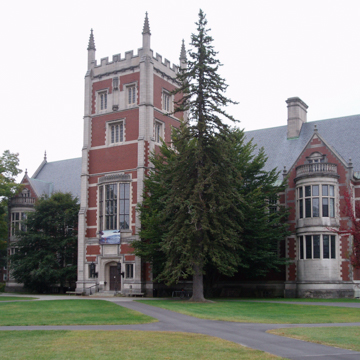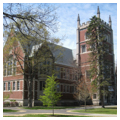Hubbard Hall completes the southern end of the Bowdoin College quadrangle. Meant to embody Bowdoin’s new emphasis on scientifically inspired German scholarship, the Gothic Revival building is a monumental structure that housed the school’s library. The two-and-a-half-story building is T-shaped in plan, and features a slightly raised basement and a steeply pitched gable roof. The 177–foot-long northern facade is punctuated at its center with a square, 100–foot-tall crenellated tower. Completed in 1903, it is built of brick, Indiana limestone, and local granite. The Gothic gables above the facade windows are crowned with Baroque curved pediments. Architect Henry Vaughan placed finials on the gable ends and included a lone gargoyle on the north end. The windows are trimmed in stone; quoins mark the corners. In 1965 Bowdoin opened the Hawthorne-Longfellow Library just to the rear of Hubbard Hall, and the former library spaces were converted into the Peary-MacMillan Arctic Museum. The building is now also now home to History, Economics, and Government and Legal Studies departments.
References
Anderson, Patricia McGraw. The Architecture of Bowdoin College.Brunswick, ME: Bowdoin College Museum of Art, 1988.

















